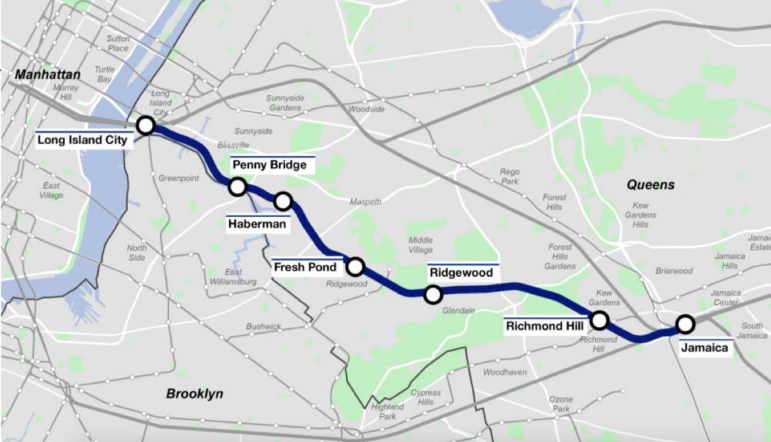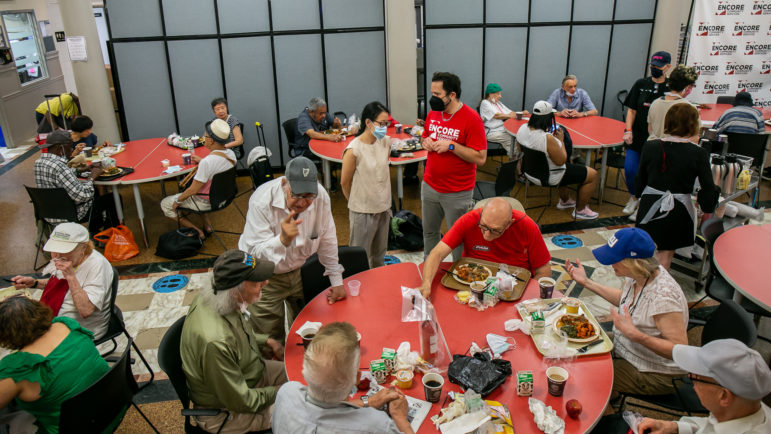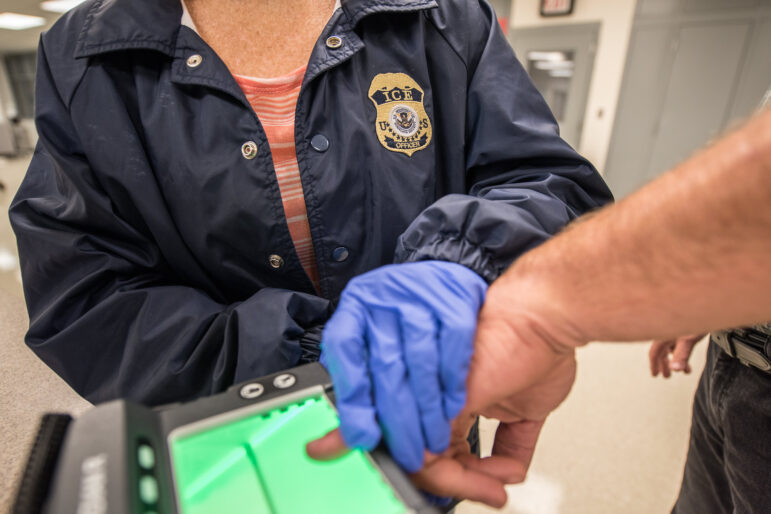
NYCDOT
The Lower Montauk Branch
When all of the proposed plans in the current MTA Capital Budget are finished, Brooklyn and the Bronx will still have better rail service and Queens will still be left with congested stations. A straphanger boarding one of Queens’ 78 New York City Transit train stations will still experience crowding at a rate 30 percent greater than that of a Brooklyn or Bronx traveler.
Queens has been oft-ignored for new rail line projects to address the transit desert crisis that has long plagued the borough. Our borough’s population is growing fast, nearing 2.4 million, and yet our infrastructure has not come close to matching that growth. Queens is the most diverse place in the entire country—with half of our residents foreign born. Our businesses reflect that diversity, and many of our shops and restaurants are rich with ethnic authenticity. We are a tourist destination without the proper public transit system for tourists to reach us.
The MTA recently announced its $51.5 billion 5-year Capital Plan to fix New York City’s transit system. And yet that plan still does not address many areas of Queens that have suffered generations of transit neglect.
New subway stops and rail lines are incredibly costly. The most recent MTA project, the 2nd Avenue Subway, had a $2.5 billion per mile cost of construction or roughly over $1 billion per station. Queens would obviously benefit from brand-new rail lines—but that is not what we are asking for. The most cost-effective solution for Queens happens to be the most feasible solution for Queens. Use existing Long Island Railroad commuter and freight lines as NYC Transit lines to expand service.
Build The QNS.
Reactivating the Lower Montauk Branch of the LIRR for NYC Transit Fares would connect residents to jobs in booming industrial hubs, student to major universities, and families to world class cultural institutions. It would connect the fastest growing census tract in the United States to the third largest transit hub in New York City, providing opportunities for new market rate and affordable housing, while helping to reduce Queens’ carbon footprint. It would service approximately 6.6 million passengers annually, promote better connections to green space, provide opportunities for safe bike paths while helping to reduce congestion on our roads.
And most importantly, the QNS would bring 9 transit stops to neglected areas of Queens without costing New York City taxpayers money. No new tracks are needed, as the QNS repurposes currently existing freight tracks.
By providing new service to hundreds of thousands of Queens residents living in areas currently considered a transit desert, the MTA will decrease commuting times for straphangers and increase the area of Queens served by the subway by 13 percent. This project will expand transit system capacity, add to the transit system resiliency, and allow for less disruptive repairs.
The QNS would help rejuvenate Queens. New expanded transit service would provide much needed opportunity for emerging small businesses and development of new market and affordable housing that is desperately needed for our Queens residents. For too long, we have seen our young people flee the borough due to lack of convenience, often flocking to areas rich with transit opportunities.
It is well past time that our public transit opportunities caught up with our borough’s growth. The QNS is that solution.
Former NYC Councilwoman Elizabeth Crowley calling for expanded service in Queens. Ms. Crowley is currently the Chair of Friends of the QNS.









6 thoughts on “Opinion: Expand Transit Service to Queens by Building the QNS”
“Opinion: Expand Transit Service to Queens by Building QNS” by former NYC Councilmember and Queens Boro President wanna-a-be Elizabeth Crowley will never happen in her life time. Here’s why. The $500,000 feasibility study sponsored by former NYC Councilmember Elizabeth Crowley for introduction of light rail on the Lower Montauk LIRR branch completed almost two years ago was the last stop for this project. The final report estimated a cost of $2.2 billion for construction of this project.
Even with a planning feasibility study, millions more would have been needed to pay for environmental documents along with preliminary design and engineering followed by final design and engineering efforts necessary to validate any basic estimates for construction costs. Crowley’s previously stated belief that it would be under $100 million never added up. New Jersey Transit’s Hudson Bergen Light Rail cost $1.2 billion and Newark Elizabeth Light Rail cost $694 million 16 years ago. Clearly costs would be far greater in today’s dollars.
There are no dollars programmed to support any work for advancement of this project contained with the MTA’s $51 billion 2020 – 2024 Five Year Capital Plan. Ditto for the MTA 2014-2034 Twenty Year Capital Needs Assessment Plan. There is also no money in the 2019 – 2020 municipal or state budgets to do the same.
The MTA NYC Transit in 1983 conducted the Queens Subway Options feasibility study for potential conversation of this LIRR branch to a subway on the ground. Intense vocal local community opposition killed this project before it progressed beyond a planning study. The same community opposition still exists decades later against introduction of any active light rail as well.
You would have to wait for approval of MTA’s next Five Year 2025 – 2029 Capital Program for any chance of MTA funding. The alternative would be 100 percent New York City funding which is very doubtful.
Rather than spend $2,2 billion to build a light rail system which could take a decade or more, why not ask the LIRR to resume service on this corridor which ended in 1998? They could run a two-car scoot service reconnecting Long Island City, Glendale and Middle Village with other communities including Richmond Hill and other intermediate stops to Jamaica.
The LIRR could use existing equipment which would afford far early implementation of service versus Light Rail. This would provide connections east bound to the J/Z and E subway lines, Kennedy Airport via Train to Plane and Jamaica LIRR Station. Queens residents traveling to jobs and colleges in Nassau and Suffolk counties would have access to all LIRR branches except the Port Washington line. Ditto for those traveling to the Barclay Center and downtown Brooklyn via the LIRR Atlantic Avenue branch.
There would also be connections west bound at either Hunters Point or Long Island City LIRR stations to the No. 7 subway line.
Cost estimates would have to be refined as progress proceeds beyond the planning and environmental phases into real and final design efforts. History has shown that estimated costs for construction usually trend upwards as projects mature toward 100 percent final design. Progression of final design refines the detailed scope of work necessary to support construction. The anticipated final potential cost would never be known until completion. Costs would be further refined by award of construction contracts followed by any unforeseen site conditions and change orders to the base contracts during the course of construction.
The proposed route will traverse several neighborhoods impacting thousands of people living nearby. How will they react to potential noise and visual impacts? There are serious legal and operational issues to be resolved with the Federal Rail Road Administration. They have regulatory jurisdiction over significant portions of the proposed route which would run on existing active freight tracks. You have to deal with light rail and freight trains coexisting on the same narrow corridor. There is no available project budget to justify key project component costs. They would have to cover a series of new stations. These will have to meet the Americans Disability Act (ADA) access standards; grade crossing, signal and safety improvements, a fleet of new light rail vehicles, land acquisition, potential business relocation along with construction of a new maintenance, operations and storage yard to support any light rail car fleet. Which neighborhood will want to step forward and host the maintenance, operations and storage yard?
Other Queens elected officials, transit riders and transit advocacy groups all have their own transportation priority projects such as the LaGuardia Airport Air Train, Woodhaven Blvd. Select Bus Service, Long Island Rail Road Rockaway Beach branch service restoration, Brooklyn-Queens Street Car Connector, Triboro X Subway Express (new subway line connecting the Bronx, Queens and Brooklyn, downtown Flushing Intermodal Bus Terminal or reopening the old Woodhaven Blvd. Atlantic Avenue Long Island Rail Road Station which may be competing against each other for the same city, state and federal funding sources.
(Larry Penner is a transportation historian, writer and advocate who previously worked 31 years for the United States Department of Transportation Federal Transit Administration Region 2 New York Office. This included the development, review, approval and oversight for billions in capital projects and programs for the MTA, NYC Transit, Long Island Rail Road, Metro North Rail Road MTA Bus along with 30 other transit agencies in NY & NJ).
And the LIRR closed the stations on the line over 20 years ago for lack of passengers.
https://www.nytimes.com/1998/03/15/nyregion/end-of-the-line-for-lirr-s-10-loneliest-stops.html
Please, please, tell us what the abbreviation QNS stands for?
I was wondering about that too…………
check out this article… very well researched.
https://ltvsquad.com/2015/10/22/disassembling-crowleys-light-rail-to-the-mall-plan/
I attended the 1983 hearing and let me tell you that part of Queens wanted no part of rail. Same along the Woodhaven branch that extends down to the Rockaways.
When I hear planners talk about reactivating these old branches – I know they have not done their homework. They look good on a map – but all politics is local and it rules the day.